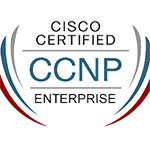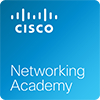ENCOR: Implementing and Operating Cisco Enterprise Network Core Technologies
Группа | Курс | Форма обучения | Период обучения | Дни недели | Время занятий |
|---|---|---|---|---|---|
| CCNP | |||||
| Интенсивное обучение | |||||
- Описание курса
- Программа курса
 Данный курс позволяет подготовиться к сертификационному тесту 350-401 ENCOR, который является частью сертификации CCNP Enterprise. Курс поможет развить знания и навыки планирования, создания и мониторинга масштабируемых сетей Cisco. CCNP - это дальнейшее карьерное продвижение для специалистов уровня CCNA.
Данный курс позволяет подготовиться к сертификационному тесту 350-401 ENCOR, который является частью сертификации CCNP Enterprise. Курс поможет развить знания и навыки планирования, создания и мониторинга масштабируемых сетей Cisco. CCNP - это дальнейшее карьерное продвижение для специалистов уровня CCNA.Требования к слушателям: знание сетей на уровне CCNA. Желательно знание английского на уровне чтения технической документации.
Продолжительность обучения: 72 часа.
Документ об окончании: международный сертификат Академии Cisco о прохождении обучения.
Все пользователи получают регистрацию на учебном портале netacad.com
Chapter 1: Packet Forwarding
1.1. Virtual LANs
1.2. Forwarding Architectures
1.3. InterVLAN routing using L3 switchesChapter 2: Spanning Tree Protocol
2.1. Spanning Tree Protocol (STP) Fundamentals
2.2. Rapid Spanning Tree Protocol (RSTP)Chapter 3: Advanced Spanning Tree
3.1. STP Topology Tuning
3.2. Additional STP Protection MechanismsChapter 4: Multiple Spanning Tree Protocol
Chapter 5: VLAN Trunks and EtherChannel Bundles
5.1. VLAN Trunking Protocol (VTP)
5.2. Dynamic Trunking Protocol (DTP)
5.3. EtherChannelChapter 6: IP Routing Essentials
6.1. Routing Protocol Overview
6.2. Path Selection
6.3. Static Routing
6.4. Virtual Routing and ForwardingChapter 7: EIGRP
7.1. EIGRP Fundamentals
7.2. Path Metric Calculation
7.3. Failure Detection and Timers
7.4. Route SummarizationChapter 8: OSPF
8.1. OSPF Fundamentals
8.2. OSPF Configuration
8.3. Default Route Advertisement
8.4. Common OSPF OptimizationsChapter 9: Advanced OSPF
9.1. Areas
9.2. Link-State Announcements
9.3. Discontiguous Network
9.4. OSPF Path Selection
9.5. Summarization of Routes
9.6. Route FilteringChapter 10: OSPFv3
10.1. OSPFv3 Fundamentals
10.2. OSPFv3 Configuration
10.3. IPv4 Support on OSPFv3Chapter 11: BGP
11.1. BGP Fundamentals
11.2. Basic BGP Configuration
11.3. Route Summarization
11.4. Multiprotocol BGP for IPv6Chapter 12: Advanced BGP
12.1. BGP Multihoming
12.2. Conditional Matching
12.3. Route-maps
12.4. BGP Route Filtering and Manipulation
12.5. BGP Communities
12.6. Understanding BGP Path SelectionChapter 13: Multicast
13.1. Multicast Fundamentals
13.2. Multicast Addressing (L2 & L3)
13.3. Internet Group Management Protocol
13.4. Protocol Independent Multicast
13.5. Rendezvous PointsChapter 14: QoS
14.1. The Need for QoS
14.2. QoS Models
14.3. Classification and Marking
14.4. Policing and Shaping
14.5. Congestion Management and AvoidanceChapter 15: IP Services
15.1. Time Synchronization
15.2. First Hop Redundancy Protocols (FHRP)
15.3. Network Address Translation (NAT)Chapter 16: Overlay Tunnels
16.1. Generic Routing Encapsulation (GRE) Tunnels
16.2. IPsec Fundamentals
16.3. Cisco Location/ID Separation Protocol (LISP)
16.4. Virtual Extensible Local Area Network (VXLAN)Chapter 17: Wireless Signals and Modulation
17.1. Understanding Basic Wireless Theory
17.2. Carrying Data Over an RF Signal
17.3. Maintaining AP-Client Compatibility
17.4. Using Multiple Radios to Scale Performance
17.5. Maximizing the AP-Client ThroughputChapter 18: Wireless Architecture Infrastructure
18.1. Wireless LAN Topologies
18.2. Pairing Lightweight APs and WLCs
18.3. Leveraging Antennas for Wireless CoverageChapter 19: Understanding Wireless Roaming and Location Services
19.1. Roaming Overview
19.2. Roaming Between Centralized Controllers
19.3. Locating Devices in a Wireless NetworkChapter 20: Authenticating Wireless Clients
20.1. Open Authentication
20.2. Authenticating with a Pre-Shared Key
20.3. Authenticating with EAP
20.4. Authenticating with WebAuthChapter 21: Troubleshooting Wireless Connectivity
21.1. Troubleshooting Client Connectivity from WLC
21.2. Troubleshooting Connectivity Problems at the APChapter 22: Enterprise Network Architecture
22.1. Hierarchical LAN Design Model
22.2. Enterprise Network Architecture OptionsChapter 23: Fabric Technologies
23.1. The Need for SD-Access
23.2. What is SD-Access?
23.3. SD-Access Architecture
23.4. What is Software-Defined WAN (SD-WAN)?
23.5 Cisco SD-WAN Architecture
23.6. Cisco SD-WAN Cloud OnRampChapter 24: Network Assurance
24.1. Network Diagnostic Tools
24.2. NetFlow
24.3. Switched Port Analyzer (SPAN) Technologies
24.4. Local SPAN
24.5. Remote SPAN (RSPAN)
24.6. Encapsulated Remote SPAN (ERSPAN)
24.7. IP SLA
24.8. Cisco DNA Center with AssuranceChapter 25: Secure Access Control
25.1. Network Security Design for Threat Defense
25.2. Next-Generation Endpoint Security
25.3. Network Access Control (NAC)Chapter 26: Network Device Access Control and Infrastructure Security
26.1. Access Control Lists (ACLs)
26.2. Terminal Lines and Password Protection
26.3. Authentication, Authorization, and Accounting (AAA)
26.4. Zone-Based Firewalls (ZBFWs)
26.5. Control Plane Policing (CoPP)
26.6. Device HardeningChapter 27: Virtualization
27.1. Server Virtualization
27.2. Network Functions VirtualizationChapter 28: Foundational Network Programmability Concepts
28.1. Command Line Interface – CLI
28.2. Application Programming Interface – API
28.3. Tools and Resources
28.4. Data Formats (XML and JSON)
28.5. Cisco DNA Center APIs
28.6. Cisco vManage APIs
28.7. Data Models and Supporting Protocols
28.8. Cisco DevNet
28.9. GitHub
28.10. Basic Python Components and ScriptsChapter 29: Introduction to Automation Tools
29.1. Embedded Event Manager (EEM)
29.2. Agent-Based Automation Tools
29.3. Agentless Automation Tools

